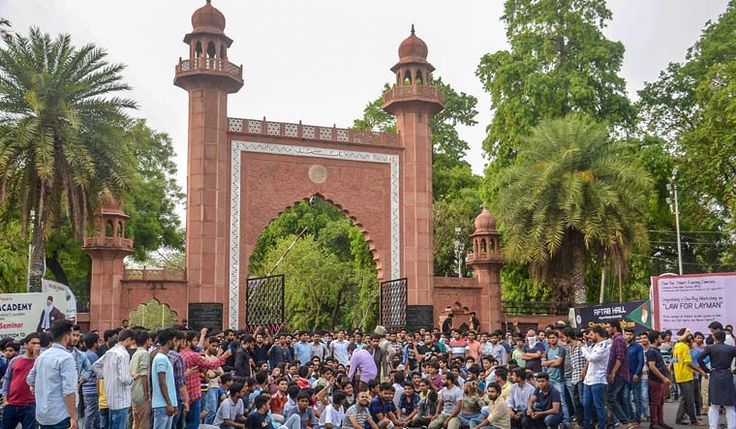Aligarh, August 10, 2025 — Student unrest at Aligarh Muslim University (AMU) intensified this week as protests over a sudden fee hike continued for a sixth day, drawing support from other institutions and igniting nationwide attention. The university administration’s explanation that the increase was “minimal and important” has done little to pacify the demonstrators demanding a full rollback.

What Sparked the Protest?
The dispute started when students browsing the university’s webpage found that tuition, continuing, and registration fees had increased by 36%. Many were blindsided by the surge, with no prior notice from the administration.One student from the B.Lib program reported the fee had surged from ₹16,000 to over ₹22,000. Postgraduate students echoed similar concerns, stating the hike would severely impact families from marginalized backgrounds.
Ground Zero: Campus Unrest
On Monday, students gathered at the Baab-e-Syed Gate, AMU’s main entrance, setting up sit-ins and forming human chains. The protest was largely student-led, with female students at the forefront. Their core demands included:
Complete rollback of the overall fees
Reinstatement of detained students
Withdrawal of allegations and FIRs filed against protestors
University Response: “Minimal & Necessary”
In response, AMU’s Proctor, Prof. Wasim Ali, issued a video statement clarifying that the fee increase ranged between ₹500–₹1,500 across different courses. He emphasized that the hike was essential for infrastructure improvements and was collectively approved by various university committees.
([turn0search0], [turn0search15])
He also dismissed exaggerations of ₹40,000+ hikes, calling them false and urging protestors to engage constructively.
([turn0search0])
Protest Turned Violent: Police Enter Campus
Tensions reached a flashpoint on Friday, when Uttar Pradesh police were permitted onto the campus to disperse protestors during Friday prayers. Students are dragged and given a lathi charge, according to accounts and videos. Tear gas was deployed, and several students were pushed violently by staff, including female students, raising serious concerns over the misuse of authority.The Doctors’ Residence Association at AMU’s medical college and student unions from DU, JNU, and others expressed solidarity and condemned the heavy-handed response. The protest was bolstered by a symbolic “White Coat March” by medical residents.
Structural Worries: Affordable Education at Risk
Former professor Mustafa Zaidi remarked that AMU has traditionally been a beacon of affordable education for economically weaker students, especially from Muslim communities. He warned that such abrupt financial changes could erode AP’s mission of inclusive access.
At a Glance: Timeline
| Date | Event |
|---|---|
| June 4 | Academic Council approves 15–20% average fee hike |
| Late July | Students notice fee hike upon portal opening |
| August 4 | Sit-in protest begins at Baab-e-Syed Gate |
| August 8 | Police intervene during Friday prayers, using force |
| Ongoing | Solidarity from national student unions; protest persists |
Broader Implications & What’s Next
The protests at AMU underscore broader echoes in India’s higher education: affordability, administrative transparency, and student voice. In an era where cost-of-living pressures loom large, institutions must tread carefully when adjusting fee structures.
The university has announced a committee to probe alleged misconduct by the proctorial team during the protest. But until tangible relief is offered, students remain defiant—and AMU finds itself at a crossroads.
Highlighting Historical Legacy of AMU
Founded as a center of learning for the marginalized, AMU has a rich history of serving students from underprivileged backgrounds. The current standoff forces the administration to reflect on whether today’s policies uphold that legacy or threaten to erode it. The resolution of this conflict will shape how future generations remember this moment.
Final Word
What began as a financial grievance has evolved into a fight over principles—justice, fairness, and the soul of an institution rooted in equity. As the protests continue and national attention grows, the university administration faces mounting pressure to balance governance with humanity.
For more newsclick here
